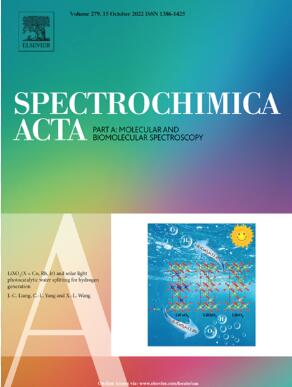简单快速制备用于水环境中微塑料超灵敏SERS检测的Au-Ag合金纳米柔性膜
IF 4.3
2区 化学
Q1 SPECTROSCOPY
Spectrochimica Acta Part A: Molecular and Biomolecular Spectroscopy
Pub Date : 2025-05-21
DOI:10.1016/j.saa.2025.126451
引用次数: 0
摘要
微塑料污染已成为水生生态系统中一个重要的环境问题。因此,开发快速、灵敏、高效的微塑料检测方法至关重要。采用真空过滤技术制备了一种新型的金银合金纳米海胆(AAA-NUs)柔性膜。该膜对水样中的聚氯乙烯(PVC)和聚乙烯(PE)微塑料具有较高的富集和检测效率。首先,采用不对称种子介导生长方法合成具有许多尖锐尖端和粗糙表面形貌的AAA-NUs,从而产生丰富的纳米间隙,有效增强表面增强拉曼散射(SERS)信号。随后,通过采用直接的真空过滤技术,大量的AAA-NUs可以快速均匀地沉积到聚四氟乙烯(PTFE)膜上。这一过程有助于形成稳定的表面增强拉曼散射(SERS)“热点”,从而显著提高传感器的灵敏度。当含有PE和PVC微塑料的水通过AAA-NUs膜时,这些微塑料被有效地捕获。利用AAA-NUs柔性膜的SERS增强特性,该方法对PE和PVC的低检出限分别为0.269 μg/mL和0.373 μg/mL,与传统SERS底物相比降低了1-2个数量级。随着便携式拉曼光谱仪的日益普及,该技术在水质评估方面具有很大的前景。本文章由计算机程序翻译,如有差异,请以英文原文为准。
A simple and rapid preparation of Au-Ag alloy nanourchins flexible membrane for ultrasensitive SERS detection of microplastics in water environment
Microplastic (MP) pollution has emerged as a significant environmental concern in aquatic ecosystems. Consequently, the development of rapid, sensitive, and efficient methods for microplastic detection is of paramount importance. This study presents a novel Au-Ag alloy nano-sea urchin (AAA-NUs) flexible membrane fabricated via a straightforward vacuum filtration technique. This membrane demonstrates high efficiency in enriching and detecting polyvinyl chloride (PVC) and polyethylene (PE) microplastics in water samples. Initially, an asymmetric seed-mediated growth method was employed to synthesize AAA-NUs with numerous sharp tips and rough surface morphologies, thereby creating abundant nano-interstices that enhance surface-enhanced Raman scattering (SERS) signals effectively. Subsequently, by employing a straightforward vacuum filtration technique, a substantial quantity of AAA-NUs can be rapidly and uniformly deposited onto the polytetrafluoroethylene (PTFE) membrane. This process facilitates the formation of stable surface-enhanced Raman scattering (SERS) “hotspots,” thereby significantly improving the sensitivity of the sensor. When water containing PE and PVC microplastics passes through the AAA-NUs membrane, these microplastics are captured efficiently. Leveraging the outstanding SERS enhancement of the AAA-NUs flexible membrane, this method achieves a low limit of detection (LOD) of 0.269 μg/mL and 0.373 μg/mL for PE and PVC, which was reduced by 1–2 orders of magnitude compared to conventional SERS substrates. With the growing prevalence of portable Raman spectrometers, this technology holds substantial promise for water quality assessment.
求助全文
通过发布文献求助,成功后即可免费获取论文全文。
去求助
来源期刊
CiteScore
8.40
自引率
11.40%
发文量
1364
审稿时长
40 days
期刊介绍:
Spectrochimica Acta, Part A: Molecular and Biomolecular Spectroscopy (SAA) is an interdisciplinary journal which spans from basic to applied aspects of optical spectroscopy in chemistry, medicine, biology, and materials science.
The journal publishes original scientific papers that feature high-quality spectroscopic data and analysis. From the broad range of optical spectroscopies, the emphasis is on electronic, vibrational or rotational spectra of molecules, rather than on spectroscopy based on magnetic moments.
Criteria for publication in SAA are novelty, uniqueness, and outstanding quality. Routine applications of spectroscopic techniques and computational methods are not appropriate.
Topics of particular interest of Spectrochimica Acta Part A include, but are not limited to:
Spectroscopy and dynamics of bioanalytical, biomedical, environmental, and atmospheric sciences,
Novel experimental techniques or instrumentation for molecular spectroscopy,
Novel theoretical and computational methods,
Novel applications in photochemistry and photobiology,
Novel interpretational approaches as well as advances in data analysis based on electronic or vibrational spectroscopy.

 求助内容:
求助内容: 应助结果提醒方式:
应助结果提醒方式:


